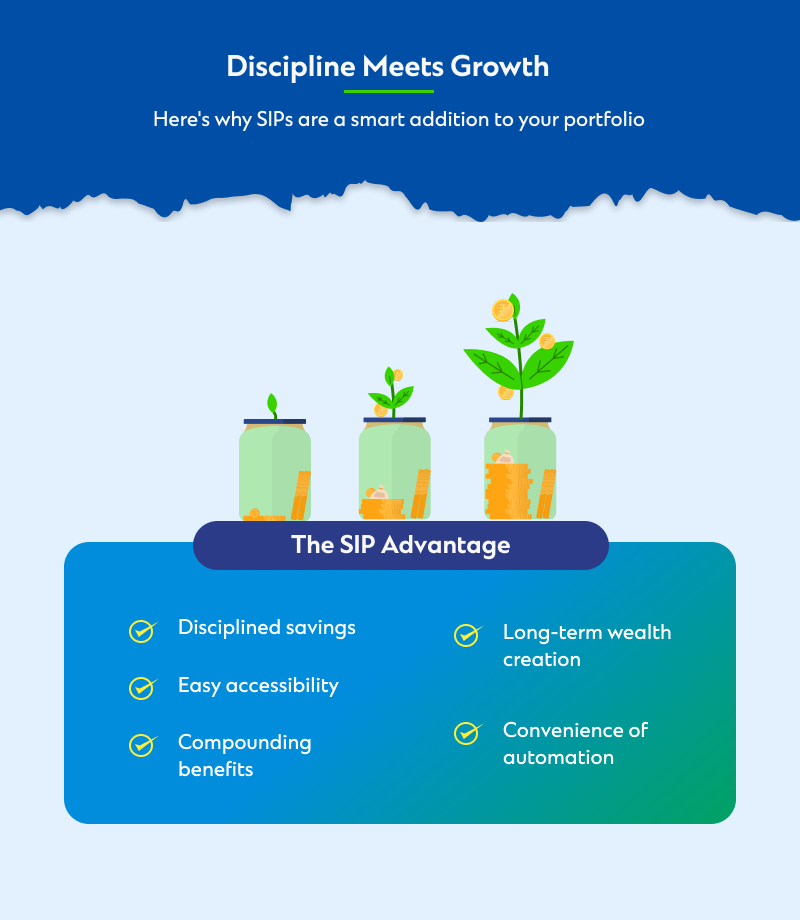

Table of Contents
SIPs have emerged as a preferred investment instrument for beginners and seasoned investors alike, to build wealth over the long term. This is because they offer consistent exposure to markets, while balancing growth with risk. And all of it, without any intervention. They’re also extremely accessible, allowing investors to start with as little as Rs 100 to Rs 500 a month or at a frequency of their choosing.
If you’re new to SIPS, however, we’ve put together this little guide explaining what SIPs are and how to begin investing in them.
SIPs: Your ticket to smart and stress-free investments
A Systematic Investment Plan (SIP) refers to the process of investing a pre-decided amount into mutual fund schemes at regular intervals of your choosing. They are designed to promote disciplined investing, while making your money work to earn more money for you. An SIP is primarily based on two tenets: Compounding and Rupee cost averaging.
Compounding: Wealth multiplication over time
When one consistently invests and reinvests their money in a mutual fund over time, they earn returns not just on their principal investment, but also on the returns that their initial investment accumulates over time. This snowball-like growth is referred to as compounding, wherein even modest (but consistent) contributions have the potential to multiply over the long term.
As investment cycles go by, your wealth can grow at an accelerated pace. The longer you stay invested, the greater the impact of compounding. This makes SIPs a powerful, disciplined approach to long-term wealth creation.
Rupee cost averaging: Your safety net
Under an SIP, one invests a fixed amount of money in mutual funds every month, regardless of the market’s ups and downs. Should the market be on an upward rally though, the Net Asset Value (NAV) of a mutual fund goes up, which means your SIP gets you fewer units in the mutual funds you’ve opted for. And when markets fall, so does the NAV of the mutual funds you’re holding units in. In this case, your SIP gets you more units.
This is referred to as Rupee cost averaging. In essence, your investments are made at a lower average cost per unit throughout the year. Which, in turn, tends to protect your portfolio against volatility, and the average purchase cost of a unit in a given mutual fund (or multiple ones) is evened out in the long run. The lower the unit cost, the better your returns.
A 7-step blueprint to smarter investing with SIPs
SIPs offer a disciplined approach to wealth creation. But setting one up requires careful planning and consideration all the same. Here’s a list of steps to help you get started.
Evaluate your financial goals
The first, and perhaps the most crucial step to begin an SIP, is to identify the long-term and short-term financial goals you’d like to fulfil. While the former may include things such as building a corpus for retirement or funding your children’s education, the latter could range from saving for a home downpayment to planning a trip abroad.
Factor in your risk appetite
Risk appetite, or risk tolerance, refers to an investor’s willingness and ability to withstand losses in the short or medium term, in anticipation of higher returns eventually. The risk tolerance of an individual investor depends on several factors.
This includes their current financial situation, their age, prior experience in the market, and so on.
Choose the most suitable investment partner for you
Once you’ve narrowed down the right investment path, the next step is to choose a partner that offers plans which align with your financial strategy, as well as the right tools to seamlessly invest in them and track their performance.
Fund Select: Your key to making informed mutual fund choices
Standard Chartered Bank’s Fund Select offers access to over 300 mutual funds from more than 15 fund houses. The variety of choices available gives you the freedom to choose funds that match your investment horizon and risk tolerance.
It also highlights the high-performing mutual funds for you, based on in-depth market analyses and your risk tolerance. These recommendations are also reviewed and refreshed on a monthly basis, allowing you to review your portfolio’s performance and rebalance it as and when required.
Choose the most appropriate plan for you
Depending on your financial goals and risk appetite, decide on how much you’re looking to invest in mutual funds every month. This, coupled with factors including the fund’s historical returns, the fund manager’s expertise, expense ratios, and exit loads, will help you decide on whether a given plan is suited to you.
Bear in mind here that it is always advisable to select and invest in multiple mutual funds: Across different sectors, market capitalisations and ones with varying underlying assets.
This ensures that even if one fund in your portfolio were to underperform, the losses incurred on it can be offset by other, better-performing funds. This process of spreading your risk and minimising losses is known as diversification. Diversification, in addition to minimising risk, also lets you leverage different management styles and the expertise of different funds, which could potentially result in an enhanced growth potential for your investments.
Strategise on your investment approach
Decide how much money you’d like to park in mutual funds, and how frequently. This is important for two reasons. First off, this will help you understand just how soon you may be able to fulfil your financial goals and aspirations. At the same time, it will also help you plan your budget for the month better, and to make sure you have enough money left for your personal expenses: Regular ones as well as those unforeseen
SIP calculator: A smarter way to plan investments
Standard Chartered Bank’s SIP calculator helps to ascertain the returns one can expect from investments made to a certain tune, over a period of time. The tool demonstrates the power of compounding returns and motivates one to invest and stay invested in mutual funds over the long term.
Set up your investment account
Depending upon the partner you choose, the process to set up an investment account for SIPs may be online or offline. Generally, you may be asked to fill out an SIP application form and submit documents including your Aadhar Card, PAN card, address proof, as well as photographs and copies of cancelled cheques, if required. to set up your account.
All of this is part of a verification referred to as the “Know your customer,” or KYC process, which is a one-time identity verification that all banks employ for security purposes, to allow you to invest in mutual funds and stock markets in the future.
Start your SIP
Lastly, once you’ve decided on a plan, set your investment account up for your pre-decided amount to be deducted from it and invested in the funds of your choice, with a frequency of your choosing.
At this stage, it is crucial to exercise discipline and avoid emotional or impulsive investing — especially during periods of high degrees of volatility. Reacting to short-term fluctuations in haste can disrupt and diminish the long-term return potential of your investments.
By remaining invested for a long time, your money gets the opportunity to grow steadily and meaningfully.

Discipline meets growth: The SIP advantage
SIPs encourage a habit of disciplined savings while providing the benefits of compounding, allowing you to grow your money over time. They’re extremely accessible to new and seasoned investors alike. What also enhances their appeal is the convenience on offer. Once you have set up an SIP, investments are automated, which enables you to stay invested without any intervention.
However, it is important to remember that SIPs don’t guarantee returns. Returns on investments made under an SIP (or otherwise) are entirely dependent on the performance of a given fund, as well as the broader market. In-depth research before investment is therefore of utmost importance. Even more so, is to periodically review and rebalance your portfolios as and when required.
Having said that, an SIP is more than just an investment — it’s a commitment to a financially stable and secure present and future, one step at a time.
FAQs for SIP management
- How much can I invest in an SIP?
You can with as little as Rs 100 to Rs 500 per month, depending on the fund’s minimum requirements. What’s more, there’s no upper limit to how much you can invest in a given fund, helping exponentially increase your potential returns. - Can I pause an SIP?
Most mutual fund SIPs allow you to pause contributions for a specific period should you be unable to contribute to it, due to other unforeseen expenses. This period may vary across funds from different fund houses. - Can I reduce or modify my SIP amount?
While it is possible to modify your SIP amount, you may be required to cancel your ongoing SIP and start a new one with the revised amount. - Do SIPs offer tax-free returns?
No. Returns from SIPs are subject to capital gains and other applicable taxes. - What’s the maximum tenure for an SIP?
SIPs can generally run indefinitely (perpetually). There’s no fixed upper limit. However, you can also choose to invest in certain mutual fund SIPs that have a fixed tenure should you be looking to save money for short-term goals such as a trip abroad or a downpayment on a car.
FAQs for SIP investments with Standard Chartered’s SC Invest
- How to start investing in SIPs through Standard Chartered Bank?
To begin investing with Standard Chartered Bank, you need to have a savings account with us. Once done, log in to your online banking account and tap ’Investment’ From there, tap on ‘Open Invest Account.’ Complete your profile by clicking on‘Customer Investment Profile.’ All you have to do now is click on ‘Online Mutual Fund’ and select the funds of your choice.
Now, to set up an SIP:
i. Log in to the SC mobile app.
ii. Click on ‘Investing’ in the menu on the left, and then select ‘SC Invest.’ Here, tap on ‘SIP.’
iii. Enter the fund name of your choice in the search bar and tap on it.
iv. Fill in your preferences, including the amount, frequency, start date, number of installments, and others, and then hit ‘Proceed.’
v. Double-check your details, accept the terms and conditions, and then hit ‘Proceed’ again.
vi. Add your nominee details on the subsequent page. Hit ‘Proceed’ again,
vii. On the next screen, authenticate your order with the OTP sent to your registered mobile number, and you’re all set! - What documents do I need to submit before starting an investment relationship with Standard Chartered Bank?
The process for setting up a mutual fund SIP is completely online. You therefore don’t need to submit any documents with us. All you have to do is follow the steps mentioned in the earlier question to get started. - Do I need to pay any fees or charges to start investing in mutual funds through Standard Chartered Bank?
Standard Chartered Bank levies no charges or fees for investing in mutual fund SIPs.



